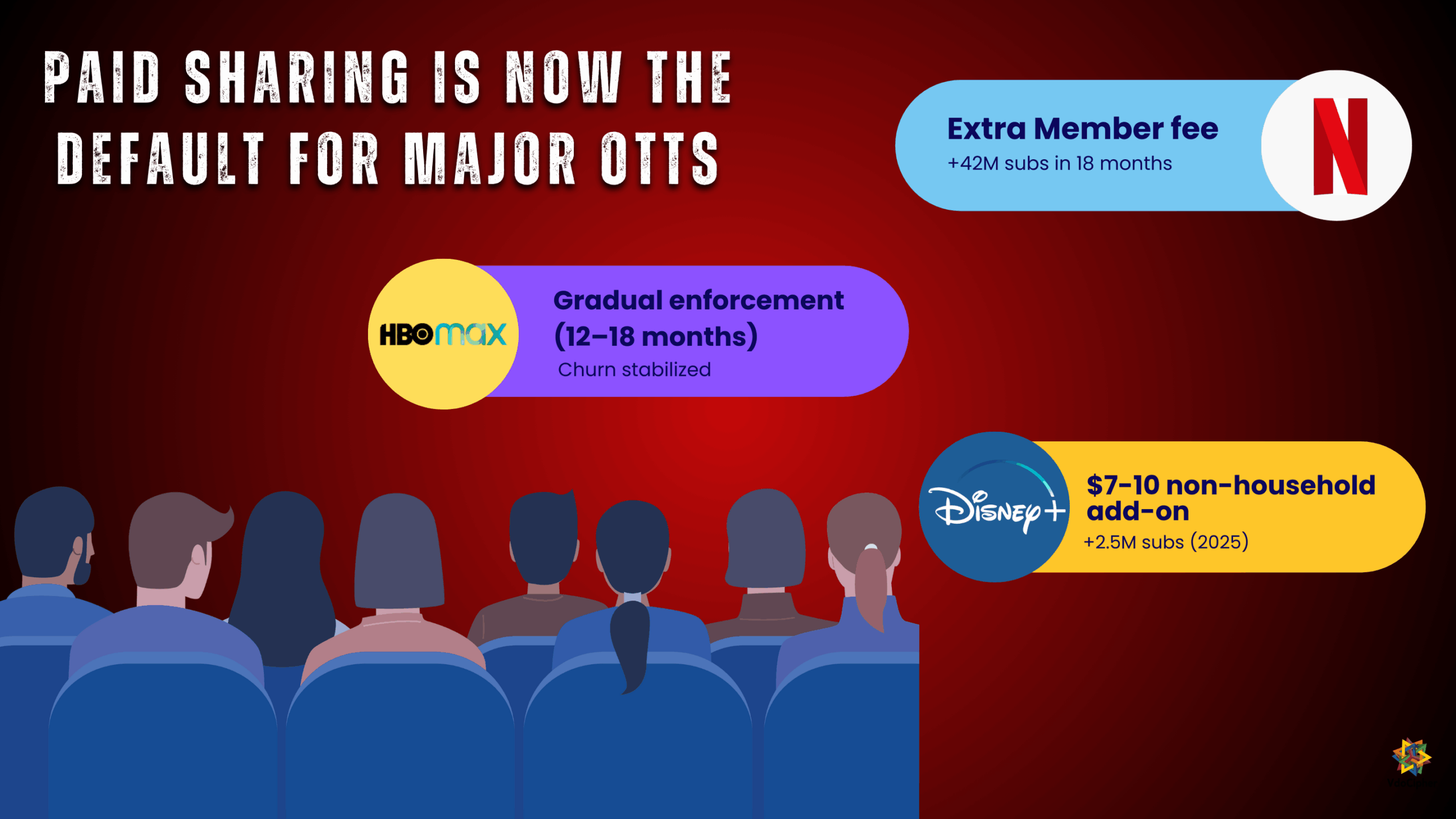From global OTT giants like Netflix and Disney+ to EdTech platforms, corporate training portals, and sports broadcasters, enforcing concurrent stream limits is about more than just revenue protection. It directly impacts server resource allocation, user experience, and piracy prevention. Without these limits, account sharing and credential abuse can cause massive financial losses, increase churn, and put premium content at risk of unauthorized distribution.
Table of Contents:
- What is Concurrent stream limit?
- Types of Concurrent Stream Limits
- Why is Concurrent Stream Limit Needed?
- What Exactly Counts a “stream”?
- How Concurrent Stream Limit Works
- Concurrent Stream Limit on Different Platforms
- How VdoCipher Handles Concurrent Stream Limits and Secure Streaming
- Best Practices for Enforcing Concurrent Stream Limits
- FAQs
What is Concurrent Stream Limit?
Concurrent stream limits define how many video streams a given user account can watch at the same time. In practical terms, if a streaming service sets a concurrent stream limit of 2 for a certain subscription plan, it means that account can have up to two videos playing concurrently (e.g. on two different devices or browser windows). Attempting a third playback would violate the limit. The term simultaneous streams is often used interchangeably with concurrent streams with both referring to parallel playback sessions.
This concept has become essential as streaming has exploded. Without limits, one paying user could share their login widely, leading to revenue loss, unfair usage, and security issues. In 2022 alone, U.S. streaming providers lost over $2.3 billion to password sharing (Netflix alone accounted for $791 million of that). By enforcing limits on concurrent streams, platforms aim to prevent account sharing piracy, ensure user fairness, and maintain service performance.
It’s important to distinguish this from the total number of devices an account can be signed into or the number of profiles under an account. A user might install the app on many devices or have multiple profiles for family members, but the concurrent stream limit is about active playbacks at one moment. For example, Netflix allows an account to be logged in on unlimited devices, but limits how many can stream at once based on the plan. If the limit is exceeded, the service will either block new playbacks or stop one of the existing streams.
Concurrent stream limiting is a way of saying “Only X streams from this account can run at the same time.” Now, why would a platform want to impose such a restriction? The reasons range from preventing piracy to enabling better user experiences.
Concurrency limits are now a standard part of subscription models. Streaming giants typically offer tiered plans with different simultaneous stream allowances. E.g. Netflix’s basic plan allows 1 stream, standard allows 2, and premium allows 4 at once. These limits both reflect the value of the plan and act as a frontline DRM strategy to curb credential sharing. After Netflix cracked down on password sharing in 2023, the effect was dramatic, paid signups surged (Netflix saw a 16.5% jump in subscribers after enforcing new sharing rules).
Other services like Disney+ followed suit with their own measures, demonstrating that controlling concurrent usage can directly boost revenue and subscriber growth by converting freeloaders into paying customers.
Beyond OTT entertainment, EdTech and online course platforms also care about concurrent stream limits. If two students share one account to watch a course simultaneously, that’s a lost sale for the platform. While some education platforms (e.g. Udemy) historically haven’t strictly enforced simultaneous login bans, the risk of multiple users exploiting a single purchase is real. Concurrency control ensures that access to paid educational content isn’t abused by account sharing, protecting instructors’ revenue. In short, concurrent stream limits matter across industries. They deter casual piracy, maximize legitimate usage, and keep the playing field fair for all users.
Types of Concurrent Stream Limits
Not all concurrency limits are one-size-fits-all. Streaming services can implement various types of limits depending on their goals and content.
| Type | Rule | Analogy | Example |
| Per-Account | Fixed streams per subscription | Gym pass (only X people can enter at once) |
Netflix (4), Disney+ (4), Prime (3)
|
| Per-Device | Limits how many devices can log in or register | Library card (share with a few, not the whole school) |
Prime: 6 devices, 2 primary
|
| Per-Content | Caps same title streaming simultaneously | Concert ticket (one seat per ticket) |
Prime: 3 total, only 2 on same movie
|
Per-User Account Limits
This is the most common type, an account-wide cap on simultaneous streams. Each user subscription is allowed a fixed number of streams at once (regardless of device). For example, a Netflix Premium account can watch on up to 4 devices at the same time, whereas the Basic plan is limited to 1. Disney+ similarly allows up to 4 concurrent streams per account, and Amazon Prime Video permits 3 streams per account (with some caveats on content). The logic here is similar to a family gym membership: one membership may let, say, four family members use the facilities at once; if a fifth tries to enter, they’re turned away. In streaming terms, the fifth simultaneous viewer would get a “stream limit reached” error until someone else stops watching.
Per-Device or Registration Limits
Some services also control how many devices can be associated or actively used under one account. A device limit is slightly different from pure concurrent streams, it might restrict the total unique devices that can ever be logged in, or require device “registration” up to a certain number. Amazon Prime takes this approach: they allow 3 concurrent streams but also cap accounts to 6 registered devices in total, with only up to 2 designated “primary” devices in a household. This prevents a user from logging into an unlimited number of gadgets over time.
The analogy here is like a library card that lets you check out books to a limited number of people, you can share the card with a few trusted family members (registered devices), but you can’t give it out to an entire school. Device registration limits add an extra layer by forcing users to manage which devices have access, thereby discouraging widespread sharing.
Per-Content (Per-Title) Concurrent Limits
Another slight difference is limiting simultaneous streams of the same piece of content. This means even if an account has multiple streams available, it cannot play the exact same movie or live event on more than a certain number of devices. Amazon Prime Video enforces this: of the 3 streams allowed, no more than 2 can be the same title at once. So a family could watch three different shows concurrently, but two people cannot watch the same movie on three devices. This rule is especially relevant for live PPV events or exclusive content. For example, a sports streaming service might allow an account to stream different games on multiple devices, but not stream the same match in two places (to prevent someone from sharing a login with a friend specifically to co-watch one event).
To tie it all together, consider a concert ticket in the physical world. One ticket gets one person into a show. You could certainly hand that ticket to a friend instead of using it yourself, but you can’t both attend the concert at the same time with one ticket. Concurrent stream limits enforce a similar principle in the digital realm: one “ticket” (account or purchase) equals a certain number of seats or screens at one time. Just as venues prevent gate-crashing by scanning tickets, streaming platforms use tech measures (tokens, device checks, etc.) to prevent digital “gate-crashing” beyond the allowed number of streams.
Why is Concurrent Stream Limit Needed?
Revenue Protection & Password Sharing – Without limits, one paid account could be used by dozens, costing platforms billions. In 2019 alone, account sharing losses were estimated at $9B, projected to reach $12.5B by 2024. Netflix’s crackdown on password sharing in 2022 proved the point: subscriber numbers rebounded as casual sharers converted to paying users. Limits make account sharing inconvenient and push households toward legitimate subscriptions.
Content Licensing Compliance – Studios and rights-holders demand safeguards. Contracts often stipulate household-only or capped-device usage. Platforms must enforce these limits to avoid violations. Some even restrict same-title streams more tightly (e.g., Amazon Prime: 3 titles at once, but only 2 devices for the same video) to prevent “virtual screenings.”
Security & Anti-Piracy – Limits reduce large-scale abuse. If a hacked login is sold online, concurrency capping quickly throttles it. Combined with forensic watermarking, it becomes easy to trace misuse and deter pirates. In practice, concurrency control is one layer in a larger anti-piracy stack alongside DRM, geo-restrictions, and device integrity checks.
Product Differentiation – Concurrency limits power tiered pricing. A single-stream plan fits individuals; families pay for 2, 4, or more. It’s a simple, marketable feature (“watch on 4 devices at once”) and an effective upsell lever. B2B platforms do the same, charging per concurrent student or per enterprise seat.
User Experience & Fair Use – Concurrency rules actually protect paying users. Without them, legitimate subscribers could be locked out by freeloaders. Reasonable caps (aligned with family use, e.g., 2-4 streams) ensure fairness. They also free up “ghost” sessions if a user forgets to log out, so one idle device doesn’t block everyone else.
Operational Benefits – Concurrency data also feeds analytics, helping platforms spot account misuse (e.g., one account constantly maxing out streams) or highlight upsell opportunities (“frequently hits the limit, suggest plan upgrade”)
What Exactly Counts a “stream”?
At first glance, a stream seems obvious: if a video is playing, that’s one stream. But in practice, platforms must define rules carefully to avoid ambiguity and misuse. Here are the key factors:
Session Scope – A stream = one active playback session (a player fetching video segments or holding a DRM license). Two browser tabs = two streams. Paused but loaded videos usually still count until closed or timed out.
Content Scope – Different titles are different streams. The same title on multiple devices also counts separately. Switching subtitles or audio doesn’t.
Device Scope – Two independent players on one device = two streams. Casting (Chromecast/AirPlay) usually counts as one, unless the app fails to close the local session.
Timing & Overlap – Concurrency is about overlap. Watching at 7pm and again at 8pm = one at a time. Platforms use heartbeats or license renewals to end inactive sessions.
Offline Downloads – Don’t count as streams while offline, but services cap how many devices can store downloads (e.g., Netflix: 6 devices on Premium).
A stream = one active playback session (player + content + device) that is alive at the same time. Clear definitions matter, because they determine whether users see concurrency errors, and they shape how fair (or exploitable) your limit system is.
How Concurrent Stream Limit Works
Enforcing concurrent stream limits is not just a single switch, it’s a coordinated process between the backend, player apps, and DRM systems. Here’s how it typically works step by step:
1. Session Creation & Tracking
When a user hits Play, the backend creates a session record tied to their account, device, and content.
These sessions are stored in a database or cache (e.g., Redis) so the system knows exactly how many streams each user has running.
Metadata like device fingerprint, IP, and last activity time helps distinguish whether it’s a new device or the same one continuing.
2. Token-Based Authentication
Instead of exposing raw video URLs, the server issues a short-lived token based url or OTP.
This token represents one playback session and may include rules like “user = Alice, allowed = 2 streams, session_id = XYZ.”
The player must present this token when requesting the video or a DRM license. If the user is already at their limit, no new token (or license) is issued.
3. DRM License Enforcement
DRM systems like Google Widevine and Apple FairPlay guard the actual content decryption.
Each playback requires a DRM license. The license server checks concurrency before issuing it: if the user is over limit, the request is denied.
For continuous enforcement, licenses can be set to expire quickly (e.g., 2-5 minutes). The player must renew them periodically, and each renewal is another chance to verify concurrency.
If the limit is exceeded mid-playback, the renewal fails, and the stream stops automatically because the content can no longer decrypt.
4. Heartbeats & Expiry
Some services add a heartbeat ping from the player to the server every 30–60 seconds: “I’m still watching.” If a user closes a tab, loses connection, or disables the player, heartbeats stop. After a grace period, the session expires and frees up a slot. This prevents “ghost sessions” from eating up the user’s concurrency allowance indefinitely.
5. Server-Side Enforcement Logic
When the system detects too many streams, platforms choose different enforcement rules:
- Block New Stream – deny the new request, existing ones continue.
- Drop Oldest – let the new stream start but forcibly stop the oldest session (common in DRM concurrency).
- Block New Device/User – allow multiple streams on one device but block additional devices.
- Prompt/Grace Period – some services let users choose which device to keep active.
6. Edge Cases
- Casting (Chromecast/AirPlay) – should count as one stream if properly implemented.
- Picture-in-Picture – still one stream, since it’s the same playback session.
- Offline Downloads – don’t count toward concurrent streams but are controlled via separate device download limits.
Concurrent Stream Limit on Different Platforms
Concurrency stream limit management has to adapt to the platform in use. The way you enforce “only X streams per account” differs depending on whether the user is on a mobile app, web browser, smart TV, or downloading content offline. Each platform has its own loopholes. For example, browsers must handle multiple tabs, mobile apps need to prevent screen capture, and offline downloads must avoid unlimited device sharing. A strong concurrency strategy considers these nuances rather than applying one blanket rule.
| Platform | Enforcement Method | Key Notes |
| Android / iOS Apps | SDK-level enforcement with Widevine / FairPlay DRM. |
Blocks screen recording and ties playback to device/app sessions.
|
| Web / Browser | Player + backend API validation with OTPs and DRM license renewals. |
Must handle multiple tabs/windows; relies on session tracking and heartbeat pings.
|
| Smart TVs | Device ID–based restriction and registration lists. |
Example: Amazon Prime allows 6 registered devices, 3 concurrent streams.
|
| Offline Downloads | DRM-encrypted files tied to device; require periodic check-ins. |
Downloads don’t count as live streams, but device caps apply (e.g., Netflix Premium: 6 devices).
|
How VdoCipher Handles Concurrent Stream Limits and Secure Streaming
VdoCipher is a secure video hosting and streaming solution widely used by EdTech and media businesses. Its toolkit combines DRM, tokenization, piracy analytics, and dynamic watermarking to enforce concurrency and stop unauthorized access.
Token-Based Authentication (OTP) – Each playback requires a short-lived, one-time OTP from VdoCipher’s API. Tokens expire quickly and can’t be reused, ensuring video sessions are tied to authenticated users. This prevents URL sharing and lets platforms control whether multiple OTPs per user are allowed.
DRM Encryption & License Control – VdoCipher uses Google Widevine and Apple FairPlay DRM. Every playback gets a secure license; attempts to exceed limits can be denied. DRM also prevent screen recording on many devices and protects keys from exposure.
Session Tracking & Analytics – The dashboard monitors watch time, device usage, and IPs per user. Abnormal patterns, like one account on multiple devices or excessive hours flag possible sharing or credential theft, letting owners intervene.
IP, Geo, & Time Restrictions – Videos can be locked to certain countries, IPs, or session durations. This helps stop accounts from being used in two distant locations or indefinitely reused.
Dynamic Watermarking – Each session can display unique overlays (e.g., email or IP). This doesn’t block concurrency directly, but deters sharing and makes leaks traceable.
Secure Offline Downloads – Downloads are encrypted with DRM and tied to the device. VdoCipher ensures offline use can’t bypass session or device limits.
Developer Integration – APIs and SDKs simplify enforcement. Developers request OTPs and VdoCipher handles DRM, watermarking, and capture blocking in the background.
Continuous Piracy Deterrence – VdoCipher combines multiple defenses, encryption, authentication, watermarking and regularly updates against new piracy tactics, ensuring concurrency limits are part of a holistic security layer.
Best Practices for Enforcing Concurrent Stream Limits
Implementing concurrent stream limits isn’t just about setting a number; it’s about balancing security, fairness, and user experience. A poorly designed system can frustrate paying customers, while a well-designed one can protect revenue without users even noticing. Here are some best practices that leading streaming platforms follow:
Use Short-Lived Tokens with Automatic Expiry – Every playback session should be authenticated by a token based URL that expires quickly and cannot be reused. This ensures that URLs or session IDs cannot be shared indefinitely.
Allow Graceful Device Switching – Users often move between devices (e.g., from phone to TV). Instead of blocking them, implement rules that automatically log out the older device when a new one starts, keeping the experience seamless while still enforcing limits.
Notify Users When Limits Are Reached – Clear, friendly messages such as “You’re streaming on too many devices” are better than silent failures. Some services even show which devices are active and let users manage them directly.
Offer Tiered Plans – Use concurrency as a feature to drive monetization. For example, 1 screen for individuals, 2 for couples, 4 for families. This both protects revenue and aligns with customer needs.
Regular Session Cleanup via Heartbeat Monitoring – Use heartbeats or DRM license renewals to automatically close idle or crashed sessions. This prevents “phantom sessions” from unfairly blocking legitimate viewers.
Combine with DRM and Watermarking – Concurrency limits alone don’t stop piracy. Pair them with DRM encryption and dynamic watermarks to deter screen recording and trace leaks back to the source.
Best Practices Per Platform
Android / iOS Apps – Use DRM SDKs (Widevine/FairPlay) to block screen capture and issue one license per device session, set to auto-expire when the app closes. This prevents multiple app instances from bypassing limits.
Web / Browser – Enforce short-lived playback tokens (OTPs) tied to user sessions and renew them every few minutes. Add a heartbeat or license renewal so idle tabs auto-expire (e.g., after 90 seconds), avoiding ghost sessions.
Smart TVs – Rely on device ID-based registration with user-facing management tools. Combine account-level stream caps with per-title limits (e.g., no more than 2 devices streaming the same movie) to protect premium content.
Offline Downloads – Encrypt downloads with DRM and tie them to device IDs. Require periodic online check-ins (e.g., every 30 days) and cap how many devices can hold downloads per account to stop unlimited sharing.
FAQs
What does concurrent stream limit mean?
It refers to the maximum number of video streams a user account can play at the same time. For example, Netflix’s premium plan allows up to 4 simultaneous streams.
How is concurrent stream limit technically enforced?
Platforms use short-lived playback tokens, DRM license controls, session tracking, and heartbeat pings to ensure only the allowed number of active streams are running per account.
What happens when a user exceeds the limit?
Typically, playback is blocked and a message appears like “You’re already streaming on X devices.” Some platforms also allow device management so users can log out old sessions.
How can concurrent stream limit improve revenue?
Crackdowns convert freeloaders into paying users. Example: Netflix gained 42 million new subscribers within 18 months of introducing paid sharing policies.
Supercharge Your Business with Videos
At VdoCipher we maintain the strongest content protection for videos. We also deliver the best viewer experience with brand friendly customisations. We'd love to hear from you, and help boost your video streaming business.


Jyoti began her career as a software engineer in HCL with UNHCR as a client. She started evolving her technical and marketing skills to become a full-time Content Marketer at VdoCipher.


Leave a Reply